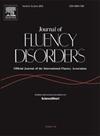A pilot study of stuttering treatment for older children (STOC)
IF 2.1
3区 医学
Q1 AUDIOLOGY & SPEECH-LANGUAGE PATHOLOGY
引用次数: 0
Abstract
Purpose
This pilot study explored an operant treatment for school-age children, Stuttering Treatment for Older Children (STOC), in increasing quality of life and the fluency of school-aged children who stutter.
Method
The participants were seven children 9–13 years old. A single-case experimental design using multiple baselines was utilized, with participants randomly assigned to baselines of different lengths. STOC is a home-based treatment program that combined time-out with a specific performance-based criteria. Recordings of children’s speech were collected routinely as monthly samples (n = 653) and during treatment sessions (n = 1551). Clinicians immediately reviewed and provided feedback on recordings of sessions. Fidelity was measured in terms of dosage, adherence, quality of the delivery, and responsiveness.
Results
For all participants, the STOC intervention showed promising results. Participant-reported quality of life significantly increased for those participants who completed the STOC program. The frequency of stuttering (percentage of syllables stuttered) decreased by an average of 72 % between the initial baseline measurement and later stages. Additionally, the quantity of speech increased by 18 %, speech sounded more natural, with naturalness scores increased by 50 %, and the severity of stuttering decreased by 56 %. Only four participants finished the intervention. This suggests that the benefits of the intervention include both overall greater well-being and less disfluencies.
Conclusions
This pilot study showed increased speech fluency and quality of life among participants who completed the intervention. However, further investigation is crucial, and we encourage the academic community to engage in this research area.
一项针对大龄儿童口吃治疗的试点研究。
目的:本初步研究探讨了一种适用于学龄儿童的有效治疗方法,即stutter treatment for Older children (STOC),以提高学龄口吃儿童的生活质量和流利程度。方法:研究对象为7名9 ~ 13岁的儿童。采用单例实验设计,使用多个基线,参与者随机分配到不同长度的基线。STOC是一种基于家庭的治疗方案,将暂停治疗与特定的基于表现的标准相结合。儿童的语言记录作为每月的样本(n = 653)和治疗期间(n = 1551)定期收集。临床医生立即对会议录音进行审查并提供反馈。保真度是根据剂量、依从性、给药质量和反应性来衡量的。结果:对于所有参与者,STOC干预显示出令人满意的结果。完成STOC项目的参与者报告的生活质量显著提高。在最初的基线测量和后期阶段之间,口吃的频率(音节口吃的百分比)平均下降了72% %。此外,说话的数量增加了18% %,说话听起来更自然,自然度分数提高了50% %,口吃的严重程度降低了56% %。只有4名参与者完成了干预。这表明,干预的好处包括总体上更大的幸福感和更少的不流畅。结论:这项初步研究表明,完成干预的参与者的语言流畅性和生活质量有所提高。然而,进一步的调查是至关重要的,我们鼓励学术界参与这一研究领域。
本文章由计算机程序翻译,如有差异,请以英文原文为准。
求助全文
约1分钟内获得全文
求助全文
来源期刊

Journal of Fluency Disorders
AUDIOLOGY & SPEECH-LANGUAGE PATHOLOGY-REHABILITATION
CiteScore
3.70
自引率
14.30%
发文量
23
审稿时长
>12 weeks
期刊介绍:
Journal of Fluency Disorders provides comprehensive coverage of clinical, experimental, and theoretical aspects of stuttering, including the latest remediation techniques. As the official journal of the International Fluency Association, the journal features full-length research and clinical reports; methodological, theoretical and philosophical articles; reviews; short communications and much more – all readily accessible and tailored to the needs of the professional.
 求助内容:
求助内容: 应助结果提醒方式:
应助结果提醒方式:


